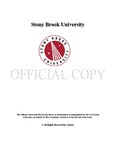| dc.identifier.uri | http://hdl.handle.net/1951/59762 | |
| dc.identifier.uri | http://hdl.handle.net/11401/70782 | |
| dc.description.sponsorship | This work is sponsored by the Stony Brook University Graduate School in compliance with the requirements for completion of degree. | en_US |
| dc.format | Monograph | |
| dc.format.medium | Electronic Resource | en_US |
| dc.language.iso | en_US | |
| dc.publisher | The Graduate School, Stony Brook University: Stony Brook, NY. | |
| dc.type | Thesis | |
| dcterms.abstract | Fluid-structure interaction (FSI) simulations were conducted in patient-specific coronary vulnerable plaque (VP) geometries reconstructed from Micro-CT and intravascular ultrasound (IVUS), in order to study the effects of several biomechanical factors on plaque vulnerability. The models reconstructed from IVUS included vessel wall, fibrous cap, lipid core and large calcifications. A model reconstructed post mortem from a coronary specimen of a patient with confirmed VP was scanned using high resolution micro-CT. This enabled capture of micro calcifications embedded in the VP fibrous cap in addition to the plaque components mentioned above. Regions susceptible to tissue failure were studied. The thin fibrous cap regions of the plaque were characterized by high stress concentrations. The presence of single or multiple micro-calcified spots embedded within the fibrous cap was studied as well. Micro-Ca significantly enhanced stresses within the fibrous cap, significantly contributing to the risk of rupture. Micro-Ca embedded in the fibrous cap produced increased stresses predicted by previously published analytical model, and corroborated our previous studies. The `micro-CT to FSI' methodology may offer better diagnostic tools for clinicians, while reducing morbidity and mortality rates for patients with vulnerable plaques and ameliorating the ensuing healthcare costs. Similarly, Fluid-Structure-Interaction (FSI) simulations of three-dimensional patient-based geometries of coronary arteries reconstructed based on Intravascular Ultrasound (IVUS) imaging dataset were performed to elucidate the correlation and dependence of crucial biomechanical risk factors, such as the fibrous cap thickness, hypertension, presence of microcalcification (micro-Ca) in the fibrous cap, and arterial anisotropy, in stress/strain distributions. It was verified that von Mises stress would exponentially increase with a fibrous cap thinner than 65 . On average, von Mises stresses increased by 32%, 34%, 30%, and 34% following a 25% simulated blood pressure elevation in the four cases studied. Stress-driven reorientation and biochemically degradation of the collagen fibers in the vessel due to atherosclerosis would potentially result in an anisotropic fibrous cap with 65?? degree fiber angles. Compared to its isotropic counterpart, a 23% von Mises stress increase was observed when the fibrous cap containing a micro-Ca was modeled as anisotropic material. IVUS based patient specific FSI simulations mapping the wall stresses and analyzing the biomechanical risk factors can be used as an additional tool for clinicians to determine proper treatment and intervention. | |
| dcterms.available | 2013-05-22T17:35:07Z | |
| dcterms.available | 2015-04-24T14:44:39Z | |
| dcterms.contributor | Qin, Yi-Xian | en_US |
| dcterms.contributor | Bluestein, Danny | en_US |
| dcterms.contributor | Lieber, Barry Baruch | en_US |
| dcterms.creator | Liang, Xuan | |
| dcterms.dateAccepted | 2013-05-22T17:35:07Z | |
| dcterms.dateAccepted | 2015-04-24T14:44:39Z | |
| dcterms.dateSubmitted | 2013-05-22T17:35:07Z | |
| dcterms.dateSubmitted | 2015-04-24T14:44:39Z | |
| dcterms.description | Department of Biomedical Engineering | en_US |
| dcterms.extent | 96 pg. | en_US |
| dcterms.format | Application/PDF | en_US |
| dcterms.format | Monograph | |
| dcterms.identifier | Liang_grad.sunysb_0771M_10906 | en_US |
| dcterms.identifier | http://hdl.handle.net/1951/59762 | |
| dcterms.identifier | http://hdl.handle.net/11401/70782 | |
| dcterms.issued | 2012-05-01 | |
| dcterms.language | en_US | |
| dcterms.provenance | Made available in DSpace on 2013-05-22T17:35:07Z (GMT). No. of bitstreams: 1
Liang_grad.sunysb_0771M_10906.pdf: 3779483 bytes, checksum: 4a5a54c622567984531ef56d88a9cb96 (MD5)
Previous issue date: 1 | en |
| dcterms.provenance | Made available in DSpace on 2015-04-24T14:44:39Z (GMT). No. of bitstreams: 3
Liang_grad.sunysb_0771M_10793.pdf.jpg: 3187 bytes, checksum: 17066d4449db985bb006951a280eccb1 (MD5)
Liang_grad.sunysb_0771M_10793.pdf.txt: 134446 bytes, checksum: 791822fbca3a95c1ec89611a3d4edd11 (MD5)
Liang_grad.sunysb_0771M_10793.pdf: 3290166 bytes, checksum: 92f434cce3c26f2d1e0a97b4eb2fb820 (MD5)
Previous issue date: 1 | en |
| dcterms.publisher | The Graduate School, Stony Brook University: Stony Brook, NY. | |
| dcterms.subject | Collagen Fiber Angle, coronary vulnerable plaque, fluid-structure interaction, IVUS, Microcalcification, micro-CT | |
| dcterms.subject | Biomechanics | |
| dcterms.title | Vulnerable Plaque Risk of Rupture Examined via Patient Based Micro-CT and IVUS Fluid-Structure Interaction Studies | |
| dcterms.type | Thesis | |

